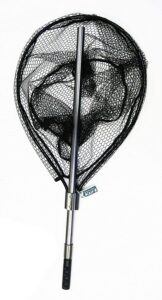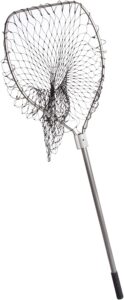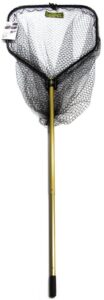Can’t find the best salmon landing net? We will help you make an informed decision.

There is no gainsaying that your salmon fishing trip becomes exciting and effective if you’re successful in netting a bountiful catch.
However, whether you’ll be able to return home with a rich haul depends upon the weather, fishing vessel-, bait-, and rod type. Apart from these factors, you’ll also require a high-quality salmon landing net.
You’ll come across various nets, from huge mesh expanses used for trawling and hauling in oceans to small handy ones used for recreational angling. How to pick the best one? We know the correct answer.
So, without further ado, let’s take a look at our list of the four best salmon landing nets.
Best Salmon Landing Nets (Comparison Table)
| Image | Model | Length | Hoop | |
|---|---|---|---|---|
 | KUFA FC7052 Landing Net (Top Pick) | 65" | 20x27x22 | Check Price |
 | Ed Cummings Landing Net (Best on a Budget) | 36" | 21x27x36 | Check Price |
 | StowMaster SS84S Landing Net (Close Runner-Up) | 56" | 24x28x24 | Check Price |
 | StowMaster TS94X Landing Net (Awesome but Pricey) | 62" | 30x32x42 | Check Price |
1. KUFA Sports FC7052 Landing Net (Editor’s Choice)
When it comes to angling, nothing can be more frustrating than losing a big catch just when you’re about to net it. You keep wondering what went wrong that enabled the salmon or trout to elude you so subtly. If you want to ensure that you’d never let go of a prized catch during your future fishing trips, then go for the KUFA Sports FC7052 landing net.
You can make the most of this retractable aluminum landing net with rubberized mesh for netting strong fish like salmon or pike. The landing mesh attached to the hoop has been crafted out of premium aluminum wire rendering the net incredibly hardy. In addition, the hoop tethered to the net is remarkably broad, having a size of 20 x 27” and together with the net’s depth of 22” comes handy for cornering large games.
The hoop’s rim, which supports the mesh all around, is fully rubberized, adding to the net’s hardiness. At the same time, the rubbery border goes a long way in making the mesh extremely catch-release friendly. In addition, the toughened anodized aluminum shaft with an octagonal hinge at the point where the handle meets the net guarantee seamless deployment.
The telescoping aluminum handle can be retracted to 41” and expanded up to 65”, thereby facilitating customized use. In addition, the spacing of the netting together with the rubberized rim minimizes water drag and snags.
Features
- Retractable and extensible anodized handle from aluminum
- Heavy-duty rubberized mesh
- Extra-large hoop
Pros
- Lightweight landing net for comfortable deployment
- Long-lasting
- The rubberized rim on the hoop makes the net catch-release friendly
Cons
- Studs for locking the unit closed would’ve added to its versatility.
2. Ed Cummings Salmon and Steelhead Net (Best on a Budget)
The ED Cumings’ Salmon and Steelhead Net’ has everything going for it, making this landing net enormously functional for anglers. Thanks to its hardwearing, large loop, and robust handle, anglers who prefer ensnaring Steelhead trout and salmon will warm up to this landing net. Additionally, the diamond embossed shaft has serrations throughout, allowing the angler to grip the unit firmly without sacrificing comfortableness.
On the other hand, the non-slip black foam grip at the handle base enables the angler to better grip, especially when landing the catch. The broadness of the bow and the deepness of the mesh facilitates trapping oversized fish like muskie, bass, or kingfish. Every component of this Ed Cumings salmon and steelhead net has been designed and crafted with meticulous care for durability.
The heavy-duty shaft and hoop made of high-quality metallic material are firmly affixed to a die-cast aluminum yoke. The sturdy non-slip grip is longer than grips of other similar landing nets and very securely wrapped around. The innovative construction ensures that the bow can handle large catches but is user-friendly and lightweight.
Features
- Broad and sturdy5/8” bow
- Bow comes with a hardy aluminum rim
- Net depth: 36”
- Tough 1 ¼” diamond embossed handle
- Black foam grip
Pros
- Remarkably lightweight: weighs 1.81 lbs (about 0.82 kg)
- Slide-a-way shaft for stowing easily in boats and trawlers
- Hardwearing hoop for handling and holding big catches
- Retractable handle
Cons
- The handle is a bit shorter than you need for a big fish
3. StowMaster SS84S Landing Net (Close-Runner-Up)
When netting the northern red snapper, redfish, or salmon, you do not need to look any further. Regardless of whether you’re angling for bonefish, tuna, or mackerel, the last thing you’d want is a flimsy landing net. And this is precisely where the SS84S landing net by StowMaster comes to your aid, letting you angle with complete peace of mind.
The StowMaster SS84S Net has been made with perfection, enabling it to pick up and handle game fish. This landing net is not only amazingly hardy but also has a good size for catching a variety of different species. The telescoping handle of the elliptical-styled SS84S has been shaped out of an outstanding extruded tube with rust-output edges for additional force and non-slip handling.
The net handle and loop frame have been crafted from aircraft-grade aluminum, making the components sturdy and lightweight. The hardwearing nylon mesh comes with a catch-release knot-free design, while the netting’s 24-inch depth aids in trapping large salmons and steelheads.
The locking pin on the handle prevents the tube from twisting or slipping when you extend or retract it.
The last word should be about the price. This excellent landing net is way more expensive than the first two we’ve already reviewed above. Compared to the KUFA Sports landing net, this one might be too pricey, but it has its perks in terms of quality.
Features
- Net bag with a depth of 24-inch
- Large hoop measuring 24 x 28 inches
- Dual-stage telescoping handle that extends up to 84 inches
- Length when stowed: 14’x 40”
- Designed and made in the US
Pros
- Easily extendable, foldable, and storable
- Perfectly sized for snapper, bonefish, redfish, salmon, and trout
- Extraordinarily hardy and resilient
Cons
- It comes at a price
- A bit on the heavier side compared to other similar landing nets
4. StowMaster TS94X Landing Net (Awesome but Expensive)
Another masterpiece, the TS94X net, is exactly what you need for salmon fishing trips.
It’s effortless to stow on your vessel. At the same time, it can be effortlessly retracted and folded for easy storage.
On the other hand, the robust rubber-dipped nylon mesh bag has no knots to avoid tangling. The bag has a depth of 42” and a hoop measuring 30” x 32”, just suitable for netting pikes and salmon.
It also has a lifetime of replacement and repair guarantee.
Overall, it might be the best salmon landing net. However, we live in the real world. I think that $200+ is too much even for such a masterpiece. That’s why it is not our top pick, but the final choice is yours.
Features
- 94-inch long retractable handle crafted from aircraft-grade aluminum alloy
- Right size net for many freshwater and saltwater game fishes
- 30 x 32” hoop, stow size; 16” x 44”, 42” deep mesh bag
Pros
- Especially treated knotless fish-friendly mesh for preventing hooks from piercing the net
- Made from aluminum for added durability
- Patented folding design to be compact in vessels
Cons
- Hefty mesh adds to the weight of the landing net
FAQs About Salmon Landing Nets
How to Net a Salmon?
After patiently waiting for an eternity, you catch sight of a spring salmon, and then a protracted tug of war ensues. And just when you get ready to net your catch with trepidation, you lose it leaving you cursing in frustration. Unfortunately, this is a scenario that many hardcore recreational anglers and fishers frequently experience when they venture for any fishing.
Contrary to what you think, netting game fishes, including but not limited to salmon, trout, redfish, and catfish, is easier said than done. Ensnaring a salmon (or any other game fish for that matter) is an art that could take years to perfect. The effortless ease with which veteran anglers and guides net schools of fishes using long-handled landing nets could make you feel that it comes easy.
However, most amateur and inexperienced fishers cannot see that it has taken years for these seasoned anglers to learn and master the netting technique. Putting things in perspective, it won’t be out of place to mention that the netter needs to coordinate with the angler for netting salmons. This section offers you a practical low-down on developing and honing the technique of netting a salmon.
Tips to Keep in Mind Using the Best Salmon Landing Net
Every time you step out for an angling expedition, remind yourself that fishes will never swim into your net voluntarily. So, your effort should be directed toward coaxing or cajoling the fish to move into your landing net. In other words, you’ve to play with your catch long enough to make her so exhausted that she will effortlessly fall into your net.
Always try to net the salmon from the front, i.e., from the face or head side, instead of netting it from the tail end. Trying to net a salmon that isn’t tired enough is a potential ticket to misery. You’ve bid your time and wait patiently till the face side of the fish is facing you. Then the angler has to pull the fish towards your vessel steadily, and after that, you’ve to carefully bring the opening of your landing net underneath the fish and net it.
Nevertheless, you’ve first to ensure that the salmon is exhausted enough, or else there’s a good likelihood that it’ll escape. Next, you’ll understand and realize that the fish is worn out if lying on one side. After that, you slowly and gradually steer the fish towards the side of your boat and pull it out of the water, applying a strong and steady force.
You’ve always to keep one thing in mind: your potential catch will always try to free itself. It will never move towards your landing net and stay put voluntarily.
The ideal distance between the netter and the angler is roughly a rod length: you can lead the fish to the net with a long sweep along the surface and not a pull-up. You must make sure that you bring the fish bit by bit towards your vessel instead of yanking it out.
If you try to wrench the head of salmon out of the water abruptly, it’ll lash forcefully, straining your line, and there’s a good chance it’ll break free. The ideal sweeping distance is nearly identical to that of the length of the fishing rod. Always thrust the net into the fish’s face; this action will alarm the fish, compelling her to move straight into the net.
Blunders to Avoid Netting the Salmon
- Never net the salmon until it becomes very tiring
- Never yank the fish suddenly out of the water
- Never take a break till the fish is inside your landing net
Conclusion: The Best Salmon Landing Net Is…
Before you decide on the landing net brand you’re going to buy, check out the product’s features. Check the handle length, extensibility, material, and storage functionality for a start. Next, inspect the mesh type that’ll work for you-rubber, coated nylon, nylon, or knotless mesh.
Also, consider the mesh size, mesh bag depth, yoke design, and loop design that’ll be suitable for you.
Overall, we think that KUFA Sports FC7052 is the best salmon landing net available on the market.